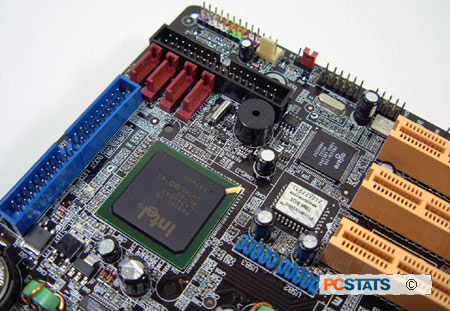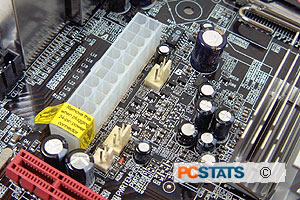AOpen i915Pa-PLF Motherboard Review
When Intel
introduced its pinless Pentium 4 processor, many
people threw their arms up and complained without fully understanding why
the move to a 775-pin package was made. The big
concern after all was that the socket 775 CPU was only supposed to be good for twenty
or so insertions. With a bit of research, the benefits of the new formfactor began to emerge, and the flood of RMA'd motherboards with
damaged sockets seemed to have been circumvented by plenty of "don't touch" warning stickers.
By leaving the socket 478 formfactor behind, new advances have certainly been made
which would have otherwise been technically impossible.
The future of Intel processor sockets
is certainly going to be pinless, as this package design allows for higher contact
densities than any pinned design. And for the moment, Intel seems to
be sticking with socket 775, even as it moves into 64-bit processing...
The AOpen i915Pa-PLF motherboard
is a socket 775 Intel Pentium 4 solution designed for mainstream
users getting ready to upgrade a little of everything. Obviously based on the Intel
915P chipset, this blackened-PCB motherboard supports current 800/533MHz FSB Socket 775 CPUs (Celeron or Pentium
4), and requires a PCI-Express compatible video card. AGP videocards are not supported at
all.
For its
class, the i915Pa-PLF is not the most well equipped motherboard out there, but
it still features the minimum of necessary peripherals users are likely to need.
Onboard components consist of 7.1-channel audio, a Gigabit NIC and IEEE 1394.
Three PCI slots and a pair of PCI Express x1 slots are present for expansion
purposes, as are four Serial ATA headers, and just one... that's ONE, IDE
connector.
Enthusiasts know
that the pinless 775 CPU socket is fragile, and that is made extra
clear (in broken English) on the cap should which reads. "Treat me
Tender!"

Generally, the layout of the i915Pa-PLF motherboard is quite good;
all the ports/headers are placed in accessible locations. I like how all the
Serial ATA, floppy and IDE connectors are placed in the same area just below
the PCI Express x16 videocard slot along the edge of the
motherboard. AOpen was obviously thinking about the enthusiast when designing the i915Pa-PLF,
two fan headers are placed right next to the videocard/Northbridge, great for anyone who
intends to use an after market videocard or specialized Northbridge cooler.
|
ATX 2.0 and the 24-Pin Power
The most obvious change with ATX 2.0 spec is the new 24-pin ATX 2.0
power connector for motherboards. Previous ATX power connectors had
20 pins, and so a special 24-20 pin adaptor must be used when an ATX
2.0 PSU is used with older motherboards.
The four extra pins include an
additional +12V, +5V, +3.3V and ground line. These new pins take the place of
the Auxiliary line which is no longer available on ATX 2.0 PSU's. ATX
2.0 also requires power supplies to natively support Serial ATA HDD's so Molex to Serial
ATA power connectors are no longer needed. ATX 2.0 does not specify how many
Serial ATA power connectors are required, however.

The first 20 pins of older ATX standard power supplies are
pin compatible with the first 20 pins of ATX 2.0, so older power supplies
will operate with ATX 2.0 motherboards just fine as long as they can
supply enough power to the motherboard. |
The Intel
ICH6 Southbridge gets quite warm during operation, as you know, but the AOpen
i915Pa-PLF does not feature an active heatsink. If it gets too hot for your
liking, there are
two mounting holes for third-party heatsink/fan combos.
If overclocking is the name of your game, a little
extra cooling down south won't hurt. AOpen has one of the stronger software
packages in the market, and included along with the i915Pa-PLF motherboard is a
full copy of Norton Anti-Virus 2004.
This should keep users safe while they're learning
the ins and outs of a new computer. If only AOpen would make the subscription
for NAV 2004 a full year instead of just 90 days, it would be even
better.
While we have no
complaints about the motherboard itself, we would have liked it if AOpen had
included more accessories. The motherboard has four Serial ATA ports and including
more than one cable would have been a nice touch.
On top of that, bundling
in some real 'rounded cables' would also have been better than including
an Ultra/133 IDE cable cut up and taped together.

